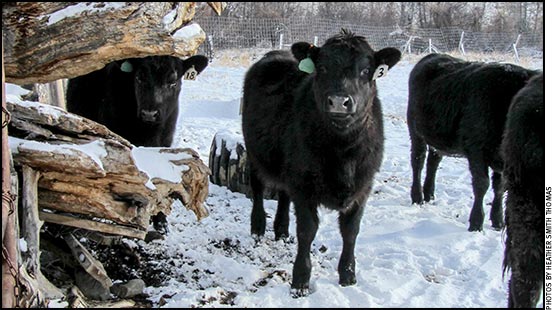HEALTH & NUTRITION...

Cold Can Cause Dehydration
Cattle may not drink enough in cold weather, and if they aren’t drinking enough, they don’t eat enough and subsequently suffer more cold stress.
When weather gets cold, cattle grow a longer, thicker hair coat. This, and a layer of fat under the hide, provides insulation to reduce heat loss and minimize cold stress. Dropping temperatures in the fall and shorter days with longer nights stimulate appetite, growth of winter hair and other physiological changes.
Body metabolism increases. Feed intake increases, and passage of feed through the digestive tract speeds up as cattle need more “fuel” to keep warm. Feed requirements may go up as much as 10% to 25%. All of these changes contribute to an increase in heat production so the animal can withstand winter temperatures. Read more.
Producers Should Prepare for Winter Supplement Needs
Expert offers protein supplementation rates for both dry and lactating cows.
Many beef producers may need a Plan B when it comes to winter forages due to dry conditions, said Jason Banta, Texas A&M AgriLife Extension Service beef cattle specialist, Overton.
Banta said supplemental feeding started earlier than usual for many producers around the state because of dry fall conditions. The Texas state climatologist’s long-term winter forecast called for warmer, drier conditions.
“Compared to 2016, we’ve been much drier, so that means less stockpiled forage and shorter pasture conditions,” Banta said. “This means producers will have to feed hay much earlier compared to recent years. The warmer temperatures would be good for winter forage growth, but below-average rain could be bad, so it’s important to plan ahead. Read more.
Caking Cows — One Way to Provide Winter Protein
Protein cake offers winter supplementation options on the range.
Many ranchers supplement cows during winter, feeding protein to balance dry pastures. Range pellets or cake are often used for this purpose.
Cows have different nutritional needs at different stages of gestation, but they all need protein — the amount increasing in late gestation. Protein requirements are higher for young cows because they are still growing. All cattle need a certain level of protein in the rumen to digest and utilize fiber. Whether protein supplementation is needed will depend on protein levels in winter forage.
Range pellets are handy for some ranchers, with various protein levels to meet various needs, and many feedmills around the country manufacture pellets. Cammack Ranch Supply, Union Center, S.D., makes a 15%, 20% and 30% protein pellet, all grain-based. The 15% and 20% pellets are wheat-based. Canola is the protein source for the 30% pellet. Read more.

Justin Sexten
Next breeding season starts now.
We can debate the single largest factor in reproductive success for the cow herd depending on gender: Is there a fertile and able bull in the herd? Are the cows cycling? A failure in either of these systems results in a miserable day come preg-check time, and anyone who has been the victim of a bull gone bad would swear the male side of this equation is the most important.
While a fertile bull is important, he is of little use to a cow that is not cycling.
Breeding soundness exams provide a foundation to sort out infertile bulls prior to breeding. On the dam side, we can’t assess reproductive abilities through a single test prior to the breeding season. However, we can judge those prospects in bred heifers and cows 45-60 days precalving. Yes, you read that correctly: precalving. That’s the time you can do something about the potential noncycling cows during the following breeding season. Read more.
Bumper Midwest Grain Crop
Low grain prices are bad for farmers but good for livestock producers.
Plentiful grain supplies likely mean low crop prices for farmers but also lower costs for livestock producers looking for feed options through winter, said a Texas A&M AgriLife Extension Service economist.
Mark Welch, AgriLife Extension grains marketing economist, College Station, said the expected drier weather pattern through winter could cause problems for cattle producers’ winter pastures and potential grazing, but abundant supplies of grains and subsequent low prices could mean lower feed costs for all livestock.
Corn prices should remain low and steady, he said, following heavy yields at harvest for U.S. and Texas producers.
“There was a whale of a corn crop this year,” he said. “Acreage was down, but with the varieties we have now and the techniques that farmers employ, those acres brought unprecedented yields.” Read more.
Preparing Cornstalks for Grazing
Nutritionist answers cornstalk-prep questions.
Fall harvest is wrapping up in the Midwest and the Plains states. The residue left behind — cornstalks — offer cattle producers a cost-effective way to feed their livestock throughout the next few months. Kevin Glaubius, director of nutrition for BioZyme Inc., took time to answer questions about grazing cornstalks and being prepared from a nutrition standpoint.
How long can producers let their cattle graze cornstalks?
At 150 bushels (bu.) an acre, approximately 1 acre of cornstalks is needed to feed a cow for 30 days. To feed the same cow on cornstalks for 60 days, 2 acres are needed. Read more.
Cattle Diseases: Common Conditions/Terms
Click here for a list of common conditions and terms related to beef cattle diseases, such as anaplasmosis, brucellosis, BVD, E. coli, IBR and others.
[Click here to go to the top of the page.]







